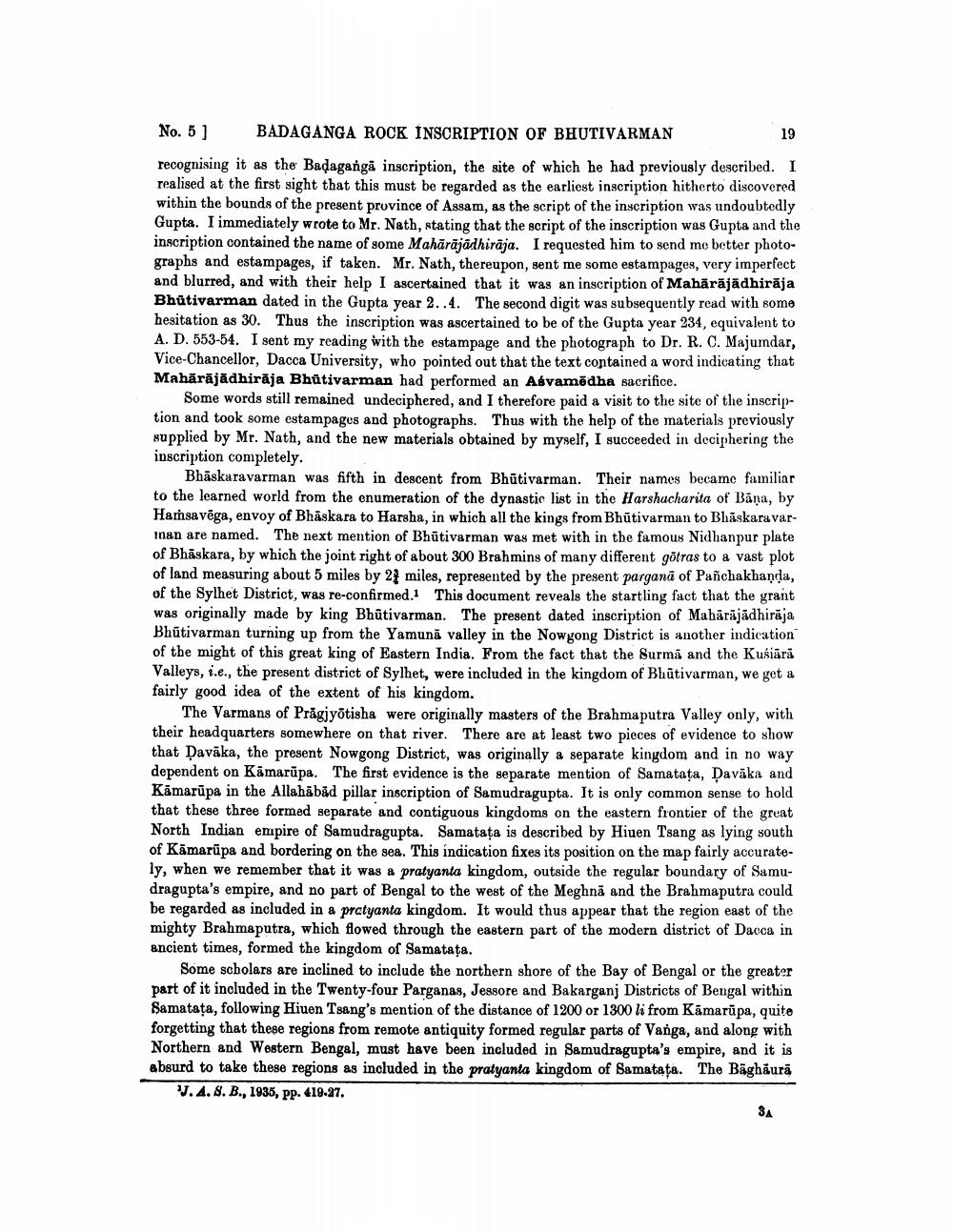________________
No. 5 ] BADAGANGA ROCK İNSCRIPTION OF BHUTIVARMAN
19 recognising it as the Badaganga inscription, the site of which he had previously described. I realised at the first sight that this must be regarded as the earliest inscription hitherto discovered within the bounds of the present province of Assam, as the script of the inscription was undoubtedly Gupta. I immediately wrote to Mr. Nath, stating that the script of the inscription was Gupta and the inscription contained the name of some Mahārājādhiraja. I requested him to send mo better photographs and estampages, if taken. Mr. Nath, thereupon, sent me some estampage, very imperfect and blurred, and with their help I ascertained that it was an inscription of Mahārājädhirāja Bhūtivarman dated in the Gupta year 2..4. The second digit was subsequently read with some hesitation as 30. Thus the inscription was ascertained to be of the Gupta year 234, equivalent to A. D. 553-54. I sent my reading with the estampage and the photograph to Dr. R. C. Majumdar, Vice-Chancellor, Dacca University, who pointed out that the text contained a word indicating that Mahārājādhirāja Bhütivarman had performed an Asvamēdha sacrifice.
Some words still remained undeciphered, and I therefore paid a visit to the site of the inscription and took some estampages and photographs. Thus with the help of the materials previously supplied by Mr. Nath, and the new materials obtained by myself, I succeeded in deciphering the inscription completely.
Bhaskaravarman was fifth in descent from Bhūtivarman. Their names became familiar to the learned world from the enumeration of the dynastie list in the Harshacharita of Bāņa, by Hamsavēga, envoy of Bhāskara to Harsha, in which all the kings from Bhūtivarman to Bhāskaravarhan are named. The next mention of Bhūtivarman was met with in the famous Nidhanpur plate of Bhāskara, by which the joint right of about 300 Brahmins of many different götras to a vast plot of land measuring about 5 miles by 27 miles, represented by the present pargana of Panchakhanda, of the Sylhet District, was re-confirmed. This document reveals the startling fact that the grant was originally made by king Bhūtivarman. The present dated inscription of Mahārājadhiraja Bhūtivarman turning up from the Yamunā valley in the Nowgong District is another indication of the might of this great king of Eastern India. From the fact that the Surma and the Kusiārā Valleys, i.e., the present district of Sylhet, were included in the kingdom of Bhūtivarman, we get a fairly good idea of the extent of his kingdom.
The Varmans of Prågjyotisha were originally masters of the Brahmaputra Valley only, with their headquarters somewhere on that river. There are at least two pieces of evidence to show that Davāka, the present Nowgong District, was originally a separate kingdom and in no way dependent on Kamarupa. The first evidence is the separate mention of Samataţa, Davāka and Kämarūpa in the Allahābād pillar inscription of Samudragupta. It is only common sense to hold that these three formed separate and contiguous kingdoms on the eastern frontier of the great North Indian empire of Samudragupta. Samatata is described by Hiuen Tsang as lying south of Kāmarūpa and bordering on the sea. This indication fixes its position on the map fairly accurately, when we remember that it was a pratyanta kingdom, outside the regular boundary of Samudragupta's empire, and no part of Bengal to the west of the Meghna and the Brahmaputra could be regarded as included in a protyanta kingdom. It would thus appear that the region east of the mighty Brahmaputra, which flowed through the eastern part of the modern district of Dacca in ancient times, formed the kingdom of Samatata.
Some scholars are inclined to include the northern shore of the Bay of Bengal or the greater part of it included in the Twenty-four Parganas, Jessore and Bakarganj Districts of Bengal within Samatata, following Hiuen Tsang's mention of the distance of 1200 or 1300 li from Kamarupa, quite forgetting that these regions from remote antiquity formed regular parts of Vanga, and along with Northern and Western Bengal, must have been included in Samudragupta's empire, and it is absurd to take these regions as included in the pratyanta kingdom of Samatata. The Baghäurā
V. A.8. B., 1935, pp. 419.27.
3




